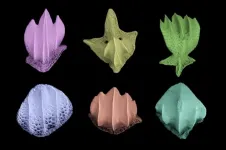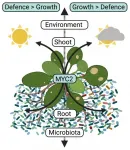(Press-News.org) For 400 million years, shark-like fishes have prowled the oceans as predators, but now humans kill 100 million sharks per year, radically disrupting ocean food chains. Based on microscopic shark scales found on fossil- and modern coral reefs in Caribbean Panama, Smithsonian scientists reveal the changing roles of sharks during the last 7000 years, both before and after sharks in this region were hunted. They hope this new use for dermal denticles will provide context for innovative reef conservation strategies.
Microscopic scales covering a shark's body--dermal denticles--reduce drag as sharks swim and protect from abrasion with hard substrates and ectoparasite attachment.
"If you have ever petted a shark in an aquarium touch tank," said Erin Dillon, who began this study as an intern at the Smithsonian Tropical Research Institute (STRI) and is now wrapping up her doctoral work at the University of California, Santa Barbara, "denticles are the reason why shark skin is rough like sandpaper if you rub it in one direction yet smooth in the other direction. Sharks are essentially covered by millions of tiny teeth."
Just as humans shed dry skin and dandruff, sharks shed their denticles, which accumulate in marine sediments. The oldest denticles found so far, in the Harding Sandstone of Colorado, are about 455 million years old.
STRI paleobiologist, Aaron O'Dea, pieces together clues from fossil- and modern coral reefs to reconstruct baseline conditions before human colonization, and to understand how ecological and evolutionary processes change through time.
"Placoderms in the Paleozoic, and then marine reptiles in the Mesozoic, were larger and ate sharks." O'Dea explained. "Placoderms ruled the oceans for around 70 million years and marine reptiles of the Mesozoic ruled for more than 100 million years. Sharks are only top predators now because extinction events preferentially took out other groups but allowed sharks to survive. Sharks seem to have remarkable evolutionary resilience and I was fascinated to work on a technique that would help us explore how sharks have fared more recently when humans step into the picture."
His team sampled material from a 7000-year-old fossilized reef in Bocas del Toro, Panama and nearby modern Caribbean reefs. O'Dea asked Erin Dillon to see if she could find shark denticles in the samples.
"What started as a three-month-long internship turned into a two-year stay in Panama and then expanded into part of my PhD thesis," Dillon said. "I've grown with this project as my role shifted from first exploring and processing the samples as an intern to leading the project, analyzing and interpreting the data, and spearheading the writing."
For each week or so of collecting samples from fossil reefs and modern coral rubble, it took about a year of lab work to recover and identify the denticles. In total, Dillon and colleagues had to sift through around 300 kilograms of reef sediments, enough to fill two bathtubs, to find the denticles they needed to know how many and what kind of sharks were in Bocas del Toro in the past. First, they used acetic acid to dissolve away the chalky sediments and then they sorted the residue under a microscope using a paintbrush to isolate the denticles.
"Finding the first denticles was thrilling," exclaimed Dillon. "They were beautifully preserved and abundant enough to provide insights into millennia-old shark communities."
But before using these fossils to uncover past shark communities, Dillon wanted to better understand the relationship between shark numbers and denticle abundances, how denticles fossilize in reef sediments, and which sharks possess which types of denticles. After publishing these studies, she could finally return to the fossil record.
She found that denticle accumulation rates, and therefore, shark abundances, were over three times higher before humans began using marine resources in the region. All denticle types declined over time, but those found on commercially valuable, fished species declined the most. The oldest samples contained a higher proportion of denticles from fast swimming, pelagic sharks like hammerheads and requiem sharks. In contrast, Dillon found that nurse shark denticles are relatively more common today than they were in the past.
To complement this evidence from the fossil record, Dillon combed through archaeological studies and historical narratives to better understand the forces that might have caused these declines. She found that the steepest decline in shark abundance occurred in the late 20th century according to these historical records. This timing coincided with the development of a shark fishery in Panama, which selectively targeted pelagic sharks. Yet, the decline in denticles belonging to nurse sharks, which are infrequently harvested both today and historically, suggested that indirect factors like the loss of coral reef habitat or prey items were also to blame.
"When the Spanish arrived in the Americas, they wrote fantastic accounts of seas swarming with sharks," Dillon said. "But these days we see very few sharks: we are lucky to see the occasional nurse shark. Our data show that sharks in Bocas del Toro have been depleted both by long-term harvesting, which accelerated in the second half of the 20th century, and by habitat degradation, which began even earlier with the expansion of banana cultivation and coastal development. There is so much land-based runoff from the coast today that in some locations it's like swimming through limeade."
"Taken together, Erin's body of work shows that denticle assemblages can be used with care to help reconstruct past shark communities through time," O'Dea said. "Sharks are an integral part of ocean health and play important roles in the great diversity and functioning of coral reefs. Having empirical estimates of past shark abundances and community composition helps us frame our understanding of what is natural in the seas."
"We hope to extend this method to other locations to examine broader geographic patterns of change in reef shark communities over long ecological timescales," Dillon said. "For example, we're currently reconstructing trends in denticle accumulation along Panama's Pacific coast over the last several thousand years using sediment cores. These baseline data will help us explore the causes and consequences of changes in shark abundance and functional diversity. Our work can also help tailor shark management goals to this local region."
INFORMATION:
This study was made possible due to generous support from Panama's Secretariat for Science and Technology (SENACYT), SNI, STRI, the Association of Marine Laboratories of the Caribbean, the Save Our Seas Foundation, the International Coral Reef Society, the Schmidt Family Foundation, the Alfred P. Sloan Foundation, M. Selin, J. Bilyk, V. and B. Anders and J. and M. Bytnar.
The Smithsonian Tropical Research Institute, headquartered in Panama City, Panama, is a unit of the Smithsonian Institution. The institute furthers the understanding of tropical biodiversity and its importance to human welfare, trains students to conduct research in the tropics and promotes conservation by increasing public awareness of the beauty and importance of tropical ecosystems. Promo video.
A study published the week of July 5 in the Proceedings of the National Academy of Sciences led by Michael Moore at Washington University in St. Louis finds that dragonfly males have consistently evolved less breeding coloration in regions with hotter climates.
"Our study shows that the wing pigmentation of dragonfly males evolves so consistently in response to the climate that it's among the most predictable evolutionary responses ever observed for a mating-related trait," said Moore, who is a postdoctoral fellow with the Living Earth Collaborative at Washington University.
"This work reveals that mating-related traits can be just as important to how organisms ...
Scientists recently made news by using fossil shark scales to reconstruct shark communities from millions of years ago. At the same time, an international team of researchers led by UC Santa Barbara ecologist Erin Dillon applied the technique to the more recent past.
Human activities have caused shark populations to plummet worldwide since records began in the mid-20th century. However, the scientists were concerned that these baseline data may, themselves, reflect shark communities that had already experienced significant declines. Dillon compared the abundance and variety of shark scales from a Panamanian coral reef 7,000 years ago to those in reef sediments ...
A vast seabird colony on Ascension Island creates a "halo" in which fewer fish live, new research shows.
Ascension, a UK Overseas Territory, is home to tens of thousands of seabirds - of various species - whose prey incudes flying fish.
The new study, by the University of Exeter and the Ascension Island Government, finds reduced flying fish numbers up to 150km (more than 90 miles) from the island - which could only be explained by the foraging of seabirds.
The findings - which provide rare evidence for a long-standing theory first proposed at Ascension - show how food-limited seabird populations naturally are, and why they are often so sensitive to competition with human fishers. ...
Nanomaterials found in consumer and health-care products can pass from the bloodstream to the brain side of a blood-brain barrier model with varying ease depending on their shape - creating potential neurological impacts that could be both positive and negative, a new study reveals.
Scientists found that metal-based nanomaterials such as silver and zinc oxide can cross an in vitro model of the 'blood brain barrier' (BBB) as both particles and dissolved ions - adversely affecting the health of astrocyte cells, which control neurological responses.
But the researchers also believe that their discovery will help to design safer nanomaterials and could open ...
Like female voles, connections between oxytocin neurons in the hypothalamus and dopamine neurons in reward areas drive parental behaviors in male voles, according to new research published in JNeurosci.
Motherhood receives most of the attention in the research world, yet in 5% of mammals -- including humans -- fathers provide care, too. The "love hormone" oxytocin plays a role in paternal care, but the exact neural pathways underlying the behavior were not known.
He et al. measured the neural activity of vole fathers while they interacted with their offspring. Oxytocin neurons connecting the hypothalamus to a reward area fired when the fathers cared for their offspring. ...
The psychedelic drug psilocybin, a naturally occurring compound found in some mushrooms, has been studied as a potential treatment for depression for years. But exactly how it works in the brain and how long beneficial results might last is still unclear.
In a new study, Yale researchers show that a single dose of psilocybin given to mice prompted an immediate and long-lasting increase in connections between neurons. The findings are published July 5 in the journal Neuron.
"We not only saw a 10% increase in the number of neuronal connections, but also they were on average about 10% larger, so the connections were stronger as well," said Yale's Alex Kwan, associate professor of psychiatry and of neuroscience and senior author of the paper.
Previous ...
A new collaborative research led by researchers from the National Institute for Environmental Studies, Potsdam Institute for Climate Impact Research, Ritsumeikan University, and Kyoto University found that although unlimited irrigation could increase global BECCS potential (via the increase of bioenergy production) by 60-71% by the end of this century, sustainably constrained irrigation would increase it by only 5-6%. The study has been published in Nature Sustainability on July 5.
Bioenergy with carbon capture and storage (BECCS) is a process of extracting bioenergy from biomass, ...
"The number of black holes is roughly three times larger than expected from the number of stars in the cluster, and it means that more than 20% of the total cluster mass is made up of black holes. They each have a mass of about 20 times the mass of the Sun, and they formed in supernova explosions at the end of the lives of massive stars, when the cluster was still very young" says Prof Mark Gieles, from the Institute of Cosmos Sciences of the University of Barcelona (ICCUB) and lead author of the paper.
Tidal streams are streams of stars that were ejected from disrupting ...
Land plants - plants that live primarily in terrestrial habitats and form vegetation on earth - are anchored to the ground through their roots, and their performance depends on both the belowground soil conditions and the aboveground climate. Plants utilize sunlight to grow through the process of photosynthesis where light energy is converted to chemical energy in chloroplasts, the powerhouses of plant cells. Therefore, the amount and quality of light perceived by chloroplasts through light absorbing pigments, such as chlorophyll, is a defining factor in plant growth and health. ...
MADISON, Wis. -- About 100 additional wolves died over the winter in Wisconsin as a result of the delisting of grey wolves under the Endangered Species Act, alongside the 218 wolves killed by licensed hunters during Wisconsin's first public wolf hunt, according to new research.
The combined loss of 313 to 323 wolves represents a decline in the state's wolf population of between 27% and 33% between April 2020 and April 2021. Researchers estimate that a majority of these additional, uncounted deaths are due to something called cryptic poaching, where poachers hide evidence of illegal killings.
The findings are the first estimate of Wisconsin's wolf population since the public hunt in February, which ended early after hunters ...



